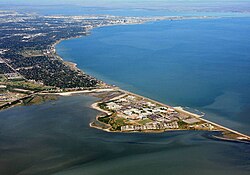Corpus Christi Bay
| Corpus Christi Bay | |
|---|---|

Corpus Christi Bay (right), Nueces Bay (top), and Oso Bay (bottom)
|
|
| Location | South Texas Gulf Coast |
| Coordinates | 27°46′20″N 97°15′10″W / 27.77222°N 97.25278°WCoordinates: 27°46′20″N 97°15′10″W / 27.77222°N 97.25278°W |
| River sources | Nueces River, Oso Creek |
| Ocean/sea sources | Gulf of Mexico |
| Basin countries | United States |
| Settlements | Corpus Christi, Portland, Ingleside, Ingleside on the Bay |
Corpus Christi Bay is a scenic semi-tropical bay on the Texas coast found in San Patricio and Nueces counties, next to the major city of Corpus Christi. It is separated from the Gulf of Mexico by Mustang Island, and is fed by the Nueces River and Oso Creek from its western and southern extensions, Nueces Bay and Oso Bay. The bay is located approximately 136 miles (219 km) south of San Antonio, and 179 miles (288 km) southwest of Houston.
Corpus Christi Bay has a rich history of human settlement along its shores that dates back millennia and is responsible for the growth of Corpus Christi, and the smaller ports of Ingleside and Portland. It is an important natural estuary that supports a diverse collection of wildlife, and attracts many tourists. The bay's abundance of petroleum and natural gas has attracted industry, and its strategic location on the Texas coast is ideal for military establishment.
The shores of Corpus Christi (or Body of Christ) Bay are thought to have been inhabited by the Karankawa Indians before the European discovery. Archeological evidence suggests that pre-Karankawa peoples used the area near Oso Bay as a burial ground between 500 BC and 500 AD. It is believed to have first been spotted by Europeans on Corpus Christi Day 1519, when Spanish explorer Alonso Álvarez de Pineda navigated its waters. Joaquín de Orobio y Basterra came across the bay in 1746, when given orders to settle the area between Tampico, Mexico, and the mouth of the San Antonio River at San Antonio Bay. He named the bay after St. Michael the Archangel, but the name did not stick and was referred to as "Corpus Christi Bay" in a 1766 report by Diego Ortiz Parrilla. Explorer Blas María de la Garza Falcón is believed to have been the first man to purchase land on the bay in 1746. Shortly thereafter the short-lived settlement of Villa de Vedoya was founded on the mouth of the Nueces River.
...
Wikipedia
